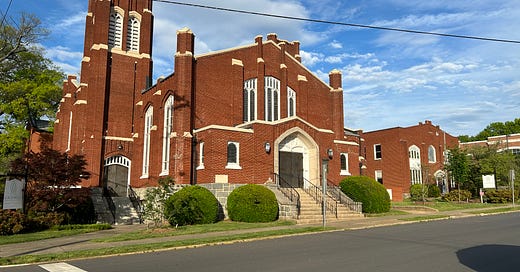Charlotte Pastor Explains How His Church Built Housing
Rev John Cleghorn and Caldwell United Methodist succeeded where few have.
Reverend John Cleghorn is the pastor of Caldwell United Methodist Church in Charlotte, North Carolina. His book Building Belonging: The Church’s Call to Create Community and House Our Neighbors came out October 14th, 2024.
ES: If you could just start off with a little bit about who you are and what the Easter's Home project is.
JC: My name is Reverend John Cleghorn, and I’m the pastor of Caldwell Presbyterian Church in Charlotte, North Carolina. Easter's Home is a 21-unit permanent supportive housing community that we are going to open in the first quarter of 2025. It will be housed in an old education wing building that we are repurposing wholly to house our neighbors.
ES: Could you tell me a little bit about how you got started on the project?
JC: Absolutely. When the church celebrated its centennial in 2012, we spent the next year, 2013, dreaming about big ideas for our second century. And we brainstormed, the congregation brainstormed about 68 ideas that made our list.
And some of them were big, hairy, audacious goals. And among those were deepening our ministry in housing. For the prior three years to that, we had hosted a 50-bed emergency overnight shelter for unhoused women.
We had really developed meaningful relationships there and come to understand the challenges of being unhoused and on the streets. And so that really influenced our decision to dedicate an underutilized building on our 1.3 acre church campus and dedicate it for 50 years to become housing for those who are chronically homeless.
ES: Were there any particular areas that your project struggled along the way?
JC: Well, it's all heavy lifting. Congregations that take up this cause will find fewer things that are more meaningful, but it is a new movement. There are differing levels of resources, depending on the locality you are in. Because we were sort of on the forefront of the movement, we ended up plowing ground that had not been broken and turned up before us.
We had to work our way through lots of issues: legal, zoning, architecture, fundraising and financing, finding a general contractor, and identifying which population we felt called to house. A lot of it was exploration that we learned from. I think different cities and different localities are starting to document and catalog the lessons learned from similar projects. But for us, it was all new learning.
We were lucky enough to have people with the right skill sets in our congregation who felt called to the work. But there's no doubt that at times it's heavy lifting, and sometimes it's two steps forward and one step back. Whether it's a legal issue or construction issue or fundraising issue, it's like putting a puzzle together. You have to have all the pieces fit right into place and that just takes time and patience. For us that was 10 years.
My research into this movement nationally finds that that's not unusual, a time frame. Ours was lengthened by the pandemic. But in general these types of initiatives for churches to put housing on their property take 5-10 years.
ES: Speaking of your research nationally, what motivated you to write a book about your experiences?
JC: In part to try to share what we had learned. I didn't want that to go to waste. I felt like this movement was starting to take off as I tried to benchmark other projects for our learning the more I looked into it.
Every call I made I would discover two or three other churches that were exploring this or had done it or maybe were in the middle of a project. But there really wasn't a book that provided a blend of examples and case studies with the biblical and theological grounding for churches and houses of faith to house their neighbor.
Then there is the increasing truth that as Christianity is reshuffled and turned on its head institutionally in America, many churches sit on very valuable land with underutilized buildings and parking lots in some of the finest and best located neighborhoods of every city in America.
As I did the research, I discovered that churches in many cases were really finding renewal and rebirth in taking on a big project with a big goal and fulfilling it. And that gave them really new missional vitality.
ES: What advice would you have for other churches that are interested in starting this process?
JC: Be very clear about several key points up front. Do not do it if you think it's going to grow your membership. It's not a strategy to try and reverse a church that has been declining in membership and lacks vitality.
Be clear about why you're doing it. Be clear in knowing what you don't know and get professionals involved in the development arena, legal arena, and financial arena as quickly as possible. And then hang in there.
It's hard work but it's profoundly fulfilling.
Eli Smith is a senior at Dartmouth College studying Religion and Public Policy. He is the Faith-Based Housing Initiative’s Research Fellow.







Thrilled to have had the opportunity to be a part of re-centering churches as the nucleus of their communities here in Charlotte. I see a bright future for the some of the best located real estate that remains in Charlotte to be developed in a thoughtful way to strengthen our communities, whether through housing, the arts, or other uses.